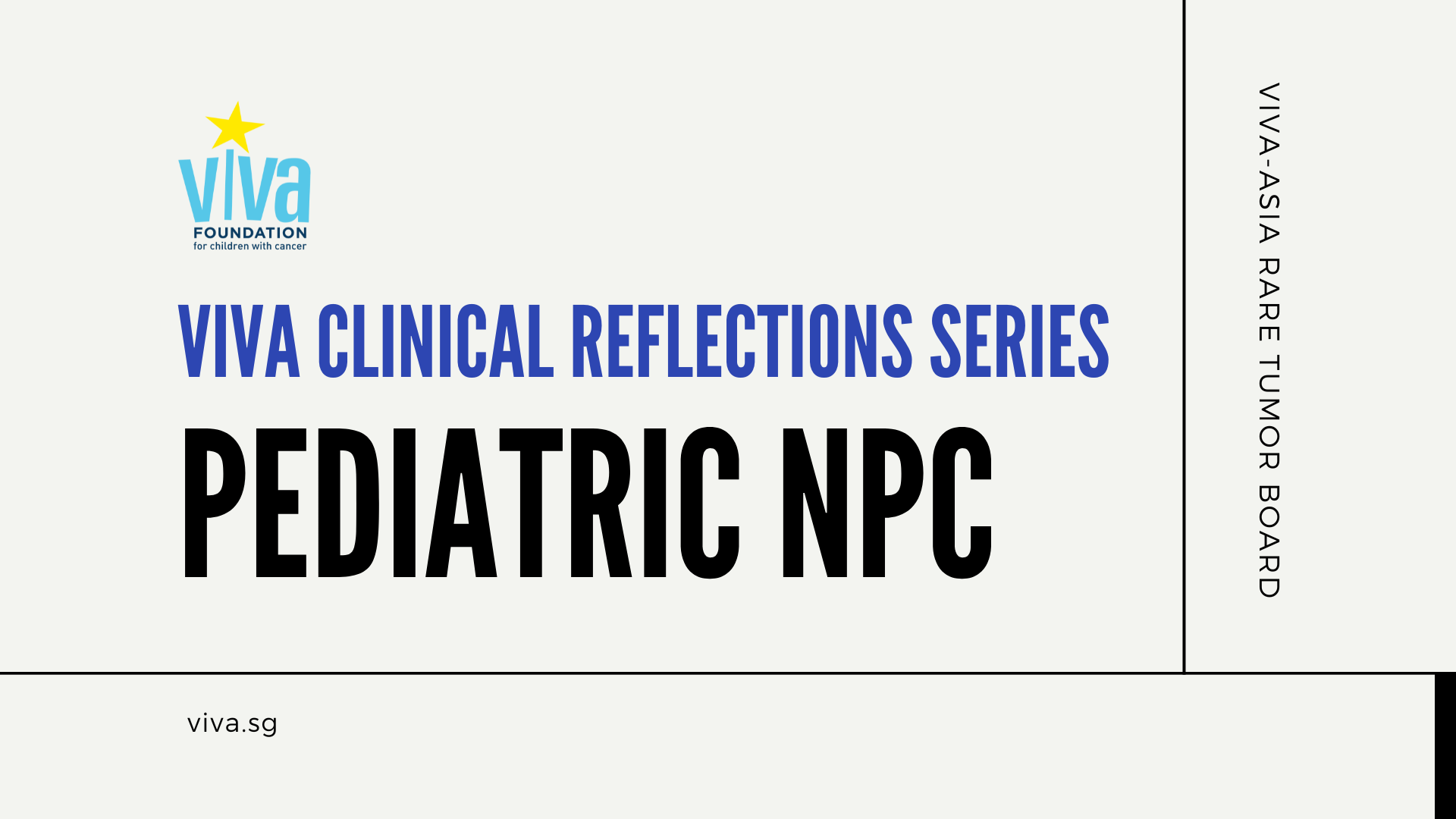
Webinar Highlights – Pediatric Nasopharyngeal Carcinoma (NPC)
Synopsis of VIVA-Asia Rare Tumour Board
22 January 2024 | 8:00PM - 9:00PM
Introduction
Pediatric Nasopharyngeal Carcinoma (NPC) is a rare malignancy associated significant long-term treatment-related complications, such as hearing loss and endocrine dysfunction. This synopsis summarizes the VIVA Rare Tumor Board discussion on Jan 22, 2024, collating experience from Hong Kong, the German GPOH consortium, with review of the literature.
Case Report and Review of Local Data from Hong Kong (Dr Calvin Hoo, Hong Kong Children's Hospital)
Sandy, a 32-year-old female, was diagnosed with NPC at age 12. She presented with epistaxis, hearing loss, tinnitus, and a cervical mass. Nasal endoscopy revealed a large nasal mass, and biopsy confirmed undifferentiated carcinoma (EBER positive). MRI showed a large nasopharyngeal mass with intracranial extension and cervical lymphadenopathy (T4N2M0, Stage 4A). She was treated with the NPC-2003-GPOH regimen (Figure 1), including induction chemotherapy (cisplatin + 5FU), chemoradiation, and maintenance interferon-beta (IFN-β) for 6 months.
Figure 1. The NPC-2003-GPOH treatment outline
She achieved complete remission (CR) with the such therapy, yet her quality of life has been devastated by long-term complications, including xerostomia, hearing loss, and panhypopituitarism. This brings about the consideration of treatment approach that are associated with less toxicities.
Local Statistics of Hong Kong
Dr Hoo and team initiated a population-based study analyzing 55 pediatric NPC cases, treated from 1993–2012, identified from the Hong Kong Cancer Registry. The age-adjusted incidence rate was 3.8/100,000/year, higher than the global rate. Of 42 analyzed patients, the male-to-female ratio was 3.2:1, with a median age of 17 at diagnosis. Most presented with locally advanced disease (85% Stage 3/4), and 19% had a family history of NPC. Treatment included intensity-modulated radiotherapy (IMRT) and chemotherapy. The 5-year and 10-year overall survival (OS) rates were 88% and 83%, respectively. Relapse occurred in 5 patients, and two developed secondary malignancies. Long-term survivors reported significant complications, including xerostomia, hearing loss, hypothyroidism, and carotid stenosis, affecting their social and occupational lives.
NPC in Children and Adolescents: The GPOH Experience (Prof. Udo Kontny, University Hospital Aachen, Germany)
Pediatric Nasopharyngeal Carcinoma (NPC): German Experience
In Germany, the incidence of NPC is 0.4 per million per year for adolescents aged 10–14, slightly higher for those aged 15–17. Similar rates are observed in the US, while Italy reports slightly higher numbers. NPC is rare in Germany, accounting for 0.1% of malignancies in patients under 18, with a median age of diagnosis at 14 years and 10 months and a male-to-female ratio of 4:1. A German cohort (2011–2017) included 63 patients, with 95% presenting with advanced disease (Stage 3 or 4). Most tumors (81%) were undifferentiated carcinoma, and 19% had squamous cell differentiation. This cohort had a higher percentage of metastatic cases, likely due to the inclusion of more severe cases during the study period.
Treatment Protocols and Outcomes
The first prospective study by Professor Mertens (1992–2003) included 59 patients with locally advanced disease (excluding metastases). Treatment involved three cycles of induction chemotherapy (cisplatin, 5FU, and methotrexate), followed by radiotherapy (59.4Gy to the primary tumor and 45Gy to lymph nodes) and six months of IFN-β maintenance. The 9-year overall survival (OS) and event-free survival (EFS) were 95% and 91%, respectively. However, 40% of patients experienced severe mucositis (Grade 3/4), prompting efforts to reduce toxicity. The subsequent NPC-2003 study (2003–2010) removed methotrexate from the regimen and reduced radiotherapy to 54Gy for complete responders. Cisplatin was added during RT at a lower dose (120mg/m²). The 5-year OS and EFS were 97% and 92%, respectively, with three systemic relapses. An extended interim study (2011–2017) of 22 patients confirmed these outcomes, with EFS and OS remaining above 90% at a median follow-up of 85 months.
Role of IFN-β
IFN-β maintenance therapy has been a key factor in the success of German protocols. Its use dates back to a 1980 case where a patient with recurrent NPC and intracranial metastases achieved complete remission after IFN-β treatment. Laboratory studies showed that IFN-β induces apoptosis in NPC cells via the TRAIL pathway, enhancing the killing of tumor cells by natural killer (NK) cells. Despite its efficacy, IFN-β is not licensed for NPC in Europe and is optional in treatment protocols.
Immunotherapy and Future Directions
The NPC Nivo study is exploring the addition of nivolumab (a PD-1 inhibitor) to induction chemotherapy. NPC tumors often express PD-L1, and early trials with PD-1 inhibitors have shown response rates of 20–26%. The study aims to increase complete response rates, allowing for reduced radiotherapy doses (54Gy) and minimizing late effects. The trial includes 57 patients across 33 German centers and is funded by the German Cancer Aid, with nivolumab provided by BMS.
Late Effects and Quality of Life
A US study found that 84% of NPC survivors experienced morbidity after 15 years, including hearing loss, hypothyroidism, and trismus. Radiotherapy dosage significantly impacts late effects, with doses below 50Gy reducing sensory hearing loss. The goal for localized disease is to reduce RT intensity, while metastatic disease requires improved systemic therapies, such as immunotherapy.
Outlook
German protocols for pediatric NPC, incorporating induction chemotherapy, reduced-dose radiotherapy, and IFN-β maintenance, have achieved excellent survival rates. However, treatment-related toxicity and late effects remain significant challenges. The ongoing NPC Nivo study aims to further improve outcomes by integrating immunotherapy, potentially reducing radiotherapy doses and sparing patients from severe late effects. Multidisciplinary care is essential to address the long-term medical and psychosocial needs of survivors.
Panel Discussion - Key Takeaways
The panel, including Prof. Godfrey Chan, Dr. Alan Chiang, Dr. Calvin Hoo, Dr. Anthony Liu, Prof. Udo Kontny, highlighted several key points:
1. Tumor Biology Across Age Groups: Pediatric NPC may have a lower mutational burden, making it more responsive to chemotherapy. Children also tolerate chemotherapy better than adults.
2. Radiotherapy (RT): RT remains crucial for curing NPC, but dosage can be reduced to 54Gy for complete responders. Advanced techniques like IMRT and proton therapy may further minimize side effects.
3. Interferon Therapy: IFN-β was chosen based on early clinical responses. Its role in inducing apoptosis via TRAIL signaling has been demonstrated in laboratory studies.
4. Immunotherapy: The addition of PD-1 inhibitors like nivolumab to induction chemotherapy shows promise in improving response rates and reducing RT dosage.
5. Long-Term Surveillance: Multidisciplinary follow-up is essential to manage late effects, including hearing loss, hypothyroidism, and dental issues.
6. Oto-Protectants: Sodium thiosulfate, though effective in reducing cisplatin-induced hearing loss, is costly and not yet widely adopted in Germany.
Conclusion
Pediatric NPC, though rare, presents significant challenges due to its advanced stage at diagnosis and long-term treatment-related complications. The NPC-2003-GPOH regimen, incorporating induction chemotherapy, reduced-dose RT, and IFN-β maintenance, has shown excellent survival outcomes. However, the high incidence of late effects underscores the need for improved treatment strategies, including immunotherapy and advanced RT techniques. Multidisciplinary care is essential to address the medical, psychological, and social needs of long-term survivors. Ongoing research, particularly in immunotherapy, holds promise for further improving outcomes and reducing treatment-related morbidity.
References:
- Buehrlen M, Zwaan CM, Granzen B, et al. Multimodal treatment, including interferon beta, of nasopharyngeal carcinoma in children and young adults: preliminary results from the prospective, multicenter study NPC-2003-GPOH/DCOG. Cancer 2012;118(19):4892-900. DOI: 10.1002/cncr.27395.
- Mertens R, Lassay L, Heimann G. [Combined treatment of nasopharyngeal cancer in children and adolescents--concept of a study]. Klin Padiatr 1993;205(4):241-8. DOI: 10.1055/s-2007-1025233.
- Kontny U, Franzen S, Behrends U, et al. Diagnosis and Treatment of Nasopharyngeal Carcinoma in Children and Adolescents - Recommendations of the GPOH-NPC Study Group. Klin Padiatr 2016;228(3):105-12. DOI: 10.1055/s-0041-111180.
- Rodriguez-Galindo C, Wofford M, Castleberry RP, et al. Preradiation chemotherapy with methotrexate, cisplatin, 5-fluorouracil, and leucovorin for pediatric nasopharyngeal carcinoma. Cancer 2005;103(4):850-7. DOI: 10.1002/cncr.20823.
- Casanova M, Ozyar E, Patte C, et al. International randomized phase 2 study on the addition of docetaxel to the combination of cisplatin and 5-fluorouracil in the induction treatment for nasopharyngeal carcinoma in children and adolescents. Cancer Chemother Pharmacol 2016;77(2):289-98. DOI: 10.1007/s00280-015-2933-2.
- Ghim TT, Briones M, Mason P, et al. Effective adjuvant chemotherapy for advanced nasopharyngeal carcinoma in children: a final update of a long-term prospective study in a single institution. J Pediatr Hematol Oncol 1998;20(2):131-5. DOI: 10.1097/00043426-199803000-00008.


